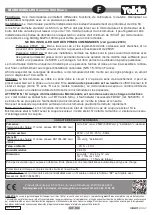
4.34
SEL-700G Relay
Instruction Manual
Date Code 20170814
Protection and Logic Functions
Group Settings (SET Command)
equal to the Idiff calculated in the previous equation. The higher pickup
setting allows a shorter or zero time delay.
The ground differential elements are enabled when the result of 87NTC equals
logical 1. The elements are blocked when the 87NTC SEL
OGIC
control
equation result equals logical 0. Typically, the element can be enabled
continuously, suggesting the logical 1 setting. Alternatively, the 87NTC can be
used to enhance security by blocking the 87N elements during high-security
mode (e.g., 87NTC := NOT HSM).
Because the ground differential elements detect generator faults, tripping
generally is applied to the generator shutdown. Refer to Trip/Close Logic
Settings for more detail and examples of tripping SEL
OGIC
control equations.
Restricted Earth Fault Element
Use the Restricted Earth Fault (REF) element to provide sensitive protection
against ground faults in your wye-connected generator winding. The element
is “restricted” in the sense that protection is restricted to ground faults within a
zone defined by the neutral and terminal CT placement. The REF is a basic
generator protection element available in the SEL-700G and SEL-700GT
relays. The REF element is intended for resistance and solidly grounded
generators, particularly where multiple generators are connected directly to a
load bus. It can also be used to protect wye-connected transformer windings.
This element should not be applied to protect high-impedance grounded
generators or transformers.
REF protection employs a neutral CT at one end of the winding and the
normal set of three CTs at the terminal end of the winding; thus, REF
protection can detect only ground faults within that particular wye-connected
winding. For REF to function, the terminal-end CTs must also be connected in
wye, because the technique uses comparison of zero-sequence currents. Delta-
connected CTs cancel out all zero-sequence components of the currents,
eliminating one of the quantities the REF element needs for comparison.
The REF implementation in the SEL-700G uses a directional element
(REF1F) that compares the direction of a polarizing current derived from the
terminal CTs with the operating current obtained from the neutral CT. A zero-
sequence current threshold supervises tripping.
Figure 4.17 shows the REF simplified enable and bypass logic. The logic
determines whether to enable the REF directional element by assertion of the
REF1EN Relay Word bit. Also, the logic detects the bypass condition of
substantial neutral current and no terminal-end current flow (Relay Word bit
REF1BYP), the situation of an internal wye-winding fault with the terminal-
end breaker open, when REF52BYP := YES. This bit is used to bypass the
main algorithm and initiate assertion of Relay Word bit REF1F (see
Figure 4.17). REF1BYP could be blocked, if intended for the previous fault,
by setting REF52BYP := NO.
Summary of Contents for SEL-700G Series
Page 14: ...This page intentionally left blank ...
Page 22: ...This page intentionally left blank ...
Page 32: ...This page intentionally left blank ...
Page 52: ...This page intentionally left blank ...
Page 106: ...This page intentionally left blank ...
Page 510: ...This page intentionally left blank ...
Page 560: ...This page intentionally left blank ...
Page 578: ...This page intentionally left blank ...
Page 588: ...This page intentionally left blank ...
Page 604: ...This page intentionally left blank ...
Page 634: ...This page intentionally left blank ...
Page 738: ...This page intentionally left blank ...
Page 802: ...This page intentionally left blank ...
















































